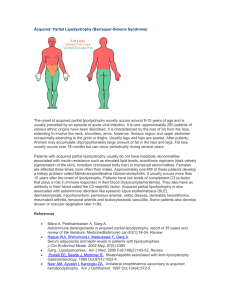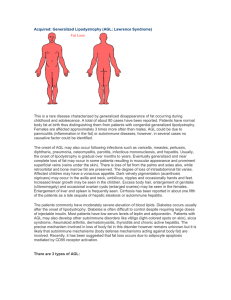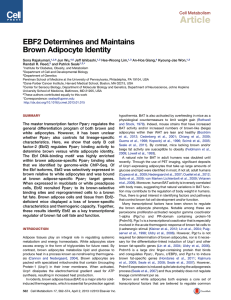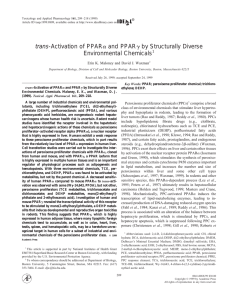Inherited: Familial Partial Lipodystrophies, other Types γ) gene mutations
advertisement
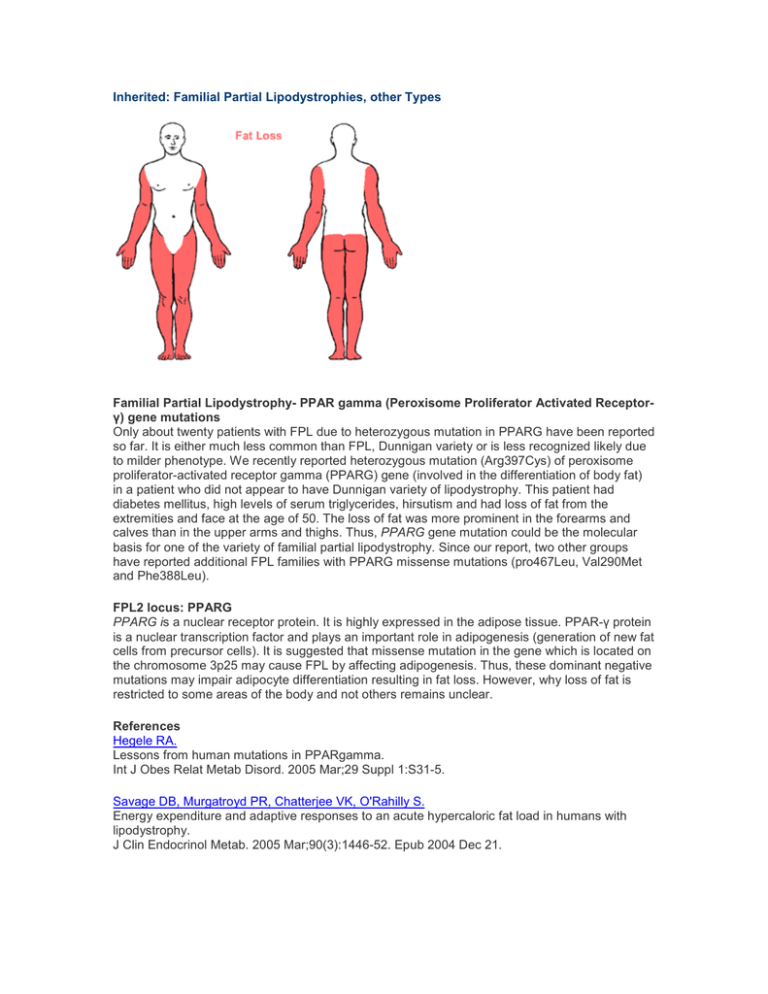
Inherited: Familial Partial Lipodystrophies, other Types Familial Partial Lipodystrophy- PPAR gamma (Peroxisome Proliferator Activated Receptorγ) gene mutations Only about twenty patients with FPL due to heterozygous mutation in PPARG have been reported so far. It is either much less common than FPL, Dunnigan variety or is less recognized likely due to milder phenotype. We recently reported heterozygous mutation (Arg397Cys) of peroxisome proliferator-activated receptor gamma (PPARG) gene (involved in the differentiation of body fat) in a patient who did not appear to have Dunnigan variety of lipodystrophy. This patient had diabetes mellitus, high levels of serum triglycerides, hirsutism and had loss of fat from the extremities and face at the age of 50. The loss of fat was more prominent in the forearms and calves than in the upper arms and thighs. Thus, PPARG gene mutation could be the molecular basis for one of the variety of familial partial lipodystrophy. Since our report, two other groups have reported additional FPL families with PPARG missense mutations (pro467Leu, Val290Met and Phe388Leu). FPL2 locus: PPARG PPARG is a nuclear receptor protein. It is highly expressed in the adipose tissue. PPAR-γ protein is a nuclear transcription factor and plays an important role in adipogenesis (generation of new fat cells from precursor cells). It is suggested that missense mutation in the gene which is located on the chromosome 3p25 may cause FPL by affecting adipogenesis. Thus, these dominant negative mutations may impair adipocyte differentiation resulting in fat loss. However, why loss of fat is restricted to some areas of the body and not others remains unclear. References Hegele RA. Lessons from human mutations in PPARgamma. Int J Obes Relat Metab Disord. 2005 Mar;29 Suppl 1:S31-5. Savage DB, Murgatroyd PR, Chatterjee VK, O'Rahilly S. Energy expenditure and adaptive responses to an acute hypercaloric fat load in humans with lipodystrophy. J Clin Endocrinol Metab. 2005 Mar;90(3):1446-52. Epub 2004 Dec 21. Herbst KL, Tannock LR, Deeb SS, Purnell JQ, Brunzell JD, Chait A. Kobberling type of familial partial lipodystrophy: an under recognized syndrome. Diabetes Care 2003; 26(6): 1819-24. Savage DB, Tan GD et al. Human metabolic syndrome resulting from dominant-negative mutations in the nuclear receptor peroxisome proliferator-activated receptor-gamma. Diabetes 2003; 52(4): 910-7. Hegele RA, Cao H, Frankowski C, Mathews ST, Leff T. PPARG F388L, a transactivation-deficient mutant, in familial partial lipodystrophy. Diabetes 2002; 51(12): 3586-90. Agarwal AK, Garg A. A novel heterozygous mutation in peroxisome proliferator-activated receptor-gamma gene in a patient with familial partial lipodystrophy. J Clin Endocrinol Metab 2002; 87(1): 408-11. Kobberling J, Schwarck H, Cremer P, Fiechtl J, Seidel D, Creutzfeldt W. Partielle Lipodystrophie mit lipatrophischem Diabetes und Hyperlipoproteinamie. Verhandlungen der deutschen Gesellschaft fur Innere Medizin 1981; 87:958-961. Kobberling J, Willms B, Kattermann R, Creutzfeldt W. Lipodystrophy of the extremities. A dominantly inherited syndrome associated with lipoatrophic diabetes. Humangenetik 1975; 29:111-120. Familial Partial Lipodystrophy due to v-AKT murine thymoma oncogene homolog 2 (AKT2) gene mutations Recently, a heterozygous missense mutation, Arg274His, in AKT2 gene was reported in several members of a family who had insulin resistance and diabetes mellitus. One of them was a 35year-old white female who developed diabetes mellitus at age 30 years, whereas her mother and grandmother harboring the same mutation developed diabetes during late thirties and a maternal uncle, a middle-aged person, had no diabetes but had hyperinsulinemia. Three of the four affected subjects had hypertension. The 35 year-old lady also had reduced body fat and partial lipodystrophy affecting mainly her extremities however, in depth evaluation of body fat distribution has not been conducted. FPL3 locus: AKT2 AKT2, also know as protein kinase B (PKB), is a phosphoinositol dedependent serine/threonine kinase and is involved in post- receptor insulin signaling. It is located on the chromosome 19q13.2. The three isoforms of AKT share more than 80% amino acid identity. Whereas, AKT1 is expressed almost everywhere, AKT2 is predominantly expressed in insulin sensitive tissues and AKT3 in the testes and brain. The mutant form of ATK2 has reduced lipid accumulating capacity. Previously, a knock-out mouse model has shown features of lipodystrophy, insulin resistance and diabetes with increasing age. Thus, loss of adipose tissue in patients with heterozygous mutations in AKT2 may either be due to reduced adipocyte differentiation or dysfunctional post receptor signaling. References Al-Shali K, Cao H, Knoers N, Hermus AR, Tack CJ, Hegele RA. A single-base mutation in the peroxisome proliferator-activated receptor gamma4 promoter associated with altered in vitro expression and partial lipodystrophy. J Clin Endocrinol Metab 2004;89:5655-60. George S, Rochford JJ, Wolfrum C, et al. A family with severe insulin resistance and diabetes due to a mutation in AKT2. Science 2004;304:1325-8






